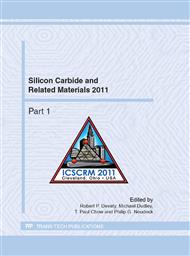p.461
p.465
p.469
p.473
p.477
p.481
p.485
p.489
p.493
Influence of Threading Dislocations on Lifetime of Gate Thermal Oxide
Abstract:
The reliability of gate oxides is a fundamental issue for realizing SiC MOSFETs. Many reports said that crystal defects shorten the lifetime of the gate oxide. And, epi defects, the basal plane dislocations and threading screw dislocations (TSD) are considered killer defects. However, because of the high TSD density of commercial SiC wafers, the exact relationship between other kinds of dislocations with lifetime has not been revealed. On the other hand, RAF wafers that we developed have low TSD density, so it is easy to evaluate the relationship between other kinds of dislocations and lifetime. By using RAF wafers, in this study, we clarified the relationship between the lifetime of the gate oxide and crystal defects. We fabricated MOS diodes and measured their lifetimes by TDDB (Time Dependent Dielectric Breakdown) measurement. The breakdown points were defined by the photo-emission method. Finally, we classified the defects by TEM (Transmission Electron Microscopy). As the results, it was clarified that threading edge dislocation (TED) decreases the lifetime as does TSD, which earlier reports said. The lifetime of the gate oxide area, in which a TED is included, was shorter by one order of magnitude than a wear-out breakdown. And, the TSD was two orders.
Info:
Periodical:
Pages:
477-480
Citation:
Online since:
May 2012
Authors:
Price:
Сopyright:
© 2012 Trans Tech Publications Ltd. All Rights Reserved
Share:
Citation:


